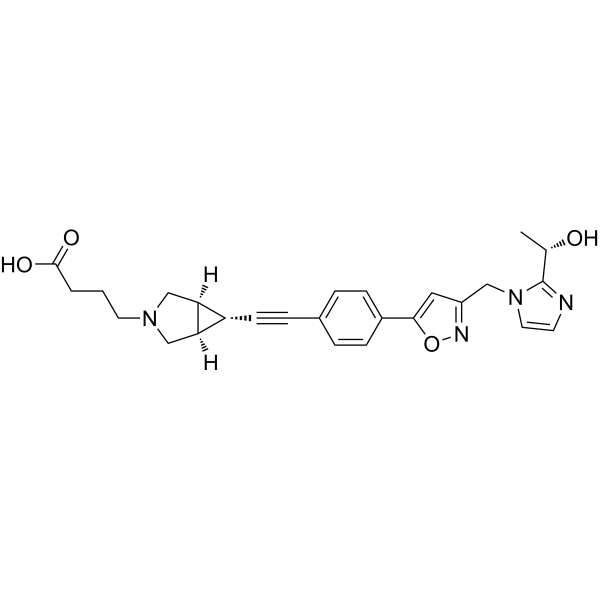Physicochemical Properties
| Molecular Formula | C26H28N4O4 |
| Molecular Weight | 460.524926185608 |
| Exact Mass | 460.211 |
| CAS # | 2427584-96-9 |
| PubChem CID | 155294517 |
| Appearance | Typically exists as solid at room temperature |
| LogP | -0.6 |
| Hydrogen Bond Donor Count | 2 |
| Hydrogen Bond Acceptor Count | 7 |
| Rotatable Bond Count | 9 |
| Heavy Atom Count | 34 |
| Complexity | 776 |
| Defined Atom Stereocenter Count | 3 |
| SMILES | C[C@@H](C1=NC=CN1CC2=NOC(=C2)C3=CC=C(C=C3)C#CC4[C@H]5[C@@H]4CN(C5)CCCC(=O)O)O |
| InChi Key | PULUMLQUYYSBOR-BOSCWZPRSA-N |
| InChi Code | InChI=1S/C26H28N4O4/c1-17(31)26-27-10-12-30(26)14-20-13-24(34-28-20)19-7-4-18(5-8-19)6-9-21-22-15-29(16-23(21)22)11-2-3-25(32)33/h4-5,7-8,10,12-13,17,21-23,31H,2-3,11,14-16H2,1H3,(H,32,33)/t17-,21?,22-,23+/m0/s1 |
| Chemical Name | 4-[(1R,5S)-6-[2-[4-[3-[[2-[(1S)-1-hydroxyethyl]imidazol-1-yl]methyl]-1,2-oxazol-5-yl]phenyl]ethynyl]-3-azabicyclo[3.1.0]hexan-3-yl]butanoic acid |
| HS Tariff Code | 2934.99.9001 |
| Storage |
Powder-20°C 3 years 4°C 2 years In solvent -80°C 6 months -20°C 1 month |
| Shipping Condition | Room temperature (This product is stable at ambient temperature for a few days during ordinary shipping and time spent in Customs) |
Biological Activity
| Targets | IC50: 0.101 μM (non-hydroxamate LpxC)[1] |
| ln Vitro | TP0586532, a substance that works well against K and has a minimal cardiovascular risk. pneumoniae, particularly those that are resistant[1]. |
| References | [1]. Ushiyama F, et al. Lead optimization of 2-hydroxymethyl imidazoles as non-hydroxamate LpxC inhibitors: Discovery of TP0586532. Bioorg Med Chem. 2021;30:115964. |
Solubility Data
| Solubility (In Vitro) | DMSO : 50 mg/mL (108.57 mM) |
| Solubility (In Vivo) |
Solubility in Formulation 1: ≥ 2.5 mg/mL (5.43 mM) (saturation unknown) in 10% DMSO + 40% PEG300 + 5% Tween80 + 45% Saline (add these co-solvents sequentially from left to right, and one by one), clear solution. For example, if 1 mL of working solution is to be prepared, you can add 100 μL of 25.0 mg/mL clear DMSO stock solution to 400 μL PEG300 and mix evenly; then add 50 μL Tween-80 to the above solution and mix evenly; then add 450 μL normal saline to adjust the volume to 1 mL. Preparation of saline: Dissolve 0.9 g of sodium chloride in 100 mL ddH₂ O to obtain a clear solution. Solubility in Formulation 2: ≥ 2.08 mg/mL (4.52 mM) (saturation unknown) in 10% DMSO + 90% (20% SBE-β-CD in Saline) (add these co-solvents sequentially from left to right, and one by one), clear solution. For example, if 1 mL of working solution is to be prepared, you can add 100 μL of 20.8 mg/mL clear DMSO stock solution to 900 μL of 20% SBE-β-CD physiological saline solution and mix evenly. Preparation of 20% SBE-β-CD in Saline (4°C,1 week): Dissolve 2 g SBE-β-CD in 10 mL saline to obtain a clear solution. Solubility in Formulation 3: ≥ 2.08 mg/mL (4.52 mM) (saturation unknown) in 10% DMSO + 90% Corn Oil (add these co-solvents sequentially from left to right, and one by one), clear solution. For example, if 1 mL of working solution is to be prepared, you can add 100 μL of 20.8 mg/mL clear DMSO stock solution to 900 μL of corn oil and mix evenly. (Please use freshly prepared in vivo formulations for optimal results.) |
| Preparing Stock Solutions | 1 mg | 5 mg | 10 mg | |
| 1 mM | 2.1715 mL | 10.8573 mL | 21.7146 mL | |
| 5 mM | 0.4343 mL | 2.1715 mL | 4.3429 mL | |
| 10 mM | 0.2171 mL | 1.0857 mL | 2.1715 mL |
